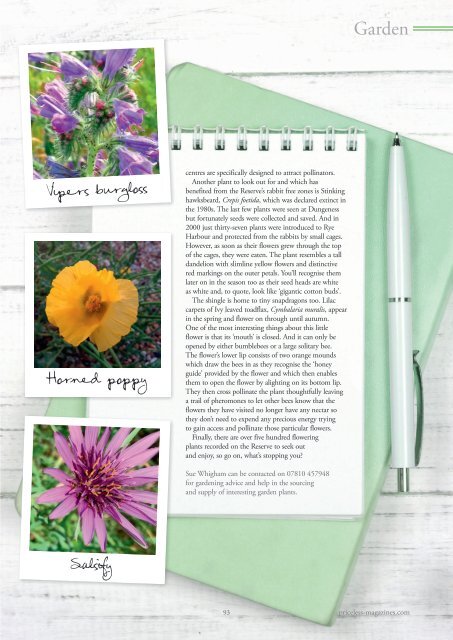Surrey Homes | SH100 | May 2023 | Something To Celebrate Supplement inside
The lifestyle magazine for Surrey - Inspirational Interiors, Fabulous Fashion, Delicious Dishes
The lifestyle magazine for Surrey - Inspirational Interiors, Fabulous Fashion, Delicious Dishes
You also want an ePaper? Increase the reach of your titles
YUMPU automatically turns print PDFs into web optimized ePapers that Google loves.
Garden<br />
Vipers burgloss<br />
Horned poppy<br />
centres are specifically designed to attract pollinators.<br />
Another plant to look out for and which has<br />
benefited from the Reserve’s rabbit free zones is Stinking<br />
hawksbeard, Crepis foetida, which was declared extinct in<br />
the 1980s. The last few plants were seen at Dungeness<br />
but fortunately seeds were collected and saved. And in<br />
2000 just thirty-seven plants were introduced to Rye<br />
Harbour and protected from the rabbits by small cages.<br />
However, as soon as their flowers grew through the top<br />
of the cages, they were eaten. The plant resembles a tall<br />
dandelion with slimline yellow flowers and distinctive<br />
red markings on the outer petals. You’ll recognise them<br />
later on in the season too as their seed heads are white<br />
as white and, to quote, look like ‘gigantic cotton buds’.<br />
The shingle is home to tiny snapdragons too. Lilac<br />
carpets of Ivy leaved toadflax, Cymbalaria muralis, appear<br />
in the spring and flower on through until autumn.<br />
One of the most interesting things about this little<br />
flower is that its ‘mouth’ is closed. And it can only be<br />
opened by either bumblebees or a large solitary bee.<br />
The flower’s lower lip consists of two orange mounds<br />
which draw the bees in as they recognise the ‘honey<br />
guide’ provided by the flower and which then enables<br />
them to open the flower by alighting on its bottom lip.<br />
They then cross pollinate the plant thoughtfully leaving<br />
a trail of pheromones to let other bees know that the<br />
flowers they have visited no longer have any nectar so<br />
they don’t need to expend any precious energy trying<br />
to gain access and pollinate those particular flowers.<br />
Finally, there are over five hundred flowering<br />
plants recorded on the Reserve to seek out<br />
and enjoy, so go on, what’s stopping you?<br />
Sue Whigham can be contacted on 07810 457948<br />
for gardening advice and help in the sourcing<br />
and supply of interesting garden plants.<br />
Salsify<br />
93 priceless-magazines.com


















